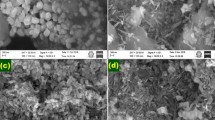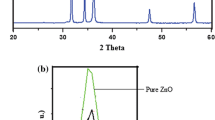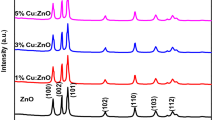Abstract
In recent years, cobalt attracted large interest in biological application, due to its biocompatibility and low toxicity. The synthesis of Co doped-ZnO/MWCNTs hybrid by a wet chemical process been reported. The results confirmed prevailing that it is the size of Zinc Oxide NPs by determines the concentration of precursor. The effect of changing the concentration of Co doping on the physical properties of the prepared samples was investigated. The X-ray diffraction showed the formation of hexagonal wurtzite structure of zinc oxide with disappearance the diffraction peaks from cobalt. The crystalline size average increased from 25.66 to 33.33 nm with increasing concentration of cobalt. FESEM images confirmed the success of the growth of spherical clusters over the surface of interlocking cylindrical tubes and their association with a crimped surface. This indicates a formation Co doped-ZnO\MWCNT hybrid. In contrast, the UV–Vis spectra revealed that all hybrid nanostructures have high absorbance as well as the band gap narrowing with increasing cobalt-doping concentration, the band gap values of Co doped-ZnO/MWCNTs hybrid with Co (2%, 4%, 6%, 8%) are 3.29, 3.04, 2.99, and 2.97 eV, respectively. Moreover, the antibacterial effect reveals that, the synthesized Co doped-ZnO/MWCNTs hybrid has high activity toward the Gram-positive and Gram-negative bacteria High inhibition efficiency shown about (17.8–22) mm for E. coli and (19.5–20.5) mm for S. aureus at high concentration of Co dopant.
Highlights
-
Prepared ZnO/MWCNTs as hybrid and Co doped-ZnO/MWCNTs hybrid by simple sol–gel method and study the effect of variation transition metals like Co on the hybrid (ZnO/MWCNTs) for the antibacterial activity of the against the E. coli and S. aureus bacteria. To our knowledge, there is no report of Co/ZnO–MWCNTs prepared by sol–gel.
-
Diethyl glycol a solvent was used in synthesizes of Co-doped ZnO/MWCNTs hybrid as the stabilizing factor, whose trap particle growth and quell particle conglomerate and gathering.
-
the incorporation of Co+2 in ZnO lattice leads to the shift in the optical absorption and band gap narrowing (BGN) of ZnO reduced with increasing cobalt-doping concentration.
-
The antibacterial activity of Co doped-ZnO–MWCNTs hybrid showed that increasing the concentration of the Co-dopant result in increasing the reactive oxygen spaces (ROS) and affected on their antibacterial activities.























Similar content being viewed by others
References
Wolf EL (2008) Nanophysics and Nanotechnology: An Introduction to Modern Concepts in Nanoscience. John Wiley & Sons, https://doi.org/10.1002/cphc.200500028
Poole Jr, CP, Owens, FJ (2003) Introduction to nanotechnology. John Wiley & Sons
Iijima S (1991) Helical microtubules of graphitic carbon. Nature 354(6348):56–58
Mirabootalebi SO, Akbari GH (2017) Methods for synthesis of carbon nanotubes—review. Int J Bio-Inorg Hybr Nanomater 6(2):49–57
Ajayan PM, Zhou OZ (2001) Applications of carbon nanotubes. Carbon nanotubes. 80:391–425
Yang N et al. (2015) Carbon nanotube based biosensors. Sens Actuators B Chem 207:690–715
Czyzowska A, Barbasz A(2020) A review: zinc oxide nanoparticles-—friends or enemies? Int J Environ Health Res 10:1–17
Ischenko V et al. (2005) Zinc oxide nanoparticles with defects. Adv Funct Mater 15(12):1945–1954
Carofiglio M et al. (2020) Doped zinc oxide nanoparticles: synthesis, characterization and potential use in nanomedicine. Appl Sci 10(15):5194
Dietl T (2010) A ten-year perspective on dilute magnetic semiconductors and oxides. Nat Mater 9(12):965–974
Al-Jawad SM, Ismail MM (2017) Characterization of Mn, cu, and (Mn, cu) co-doped ZnS nanoparticles. J Opt Technol 84(7):495–499
Largani SH, Pasha MA (2017) The effect of concentration ratio and type of functional group on synthesis of CNT–ZnO hybrid nanomaterial by an in situ sol–gel process. Int Nano Lett 7(1):25–33
Al-Jawad SM, Elttayf AK, Saber AS (2017) Influence of annealing temperature on the characteristics of nanocrystalline SnO2 thin films produced by sol–gel and chemical bath deposition for gas sensor applications. Surf Rev Lett 24(07):1750104
Singh NK, Koutu V, Malik M (2019) Enhancement of room temperature ferromagnetic behavior of Co-doped ZnO nanoparticles synthesized via sol–gel technique. J Sol–Gel Sci Technol 91(2):324–334
Maensiri S et al. (2006) Magnetic behavior of nanocrystalline powders of Co-doped ZnO diluted magnetic semiconductors synthesized by polymerizable precursor method. J Magn Magn Mater 301(2):422–432
Zak AK et al. (2011) Effects of annealing temperature on some structural and optical properties of ZnO nanoparticles prepared by a modified sol–gel combustion method. Ceram Int 37(1):393–398
do Amaral Montanheiro TL et al. (2015) Effect of MWCNT functionalization on thermal and electrical properties of PHBV/MWCNT nanocomposites. J Mater Res 30(1):55–65
Al-Jawad SM, Salman ON, Yousif NA (2019) Influence of growth time on structural, optical and electrical properties of TiO2 nanorod arrays deposited by hydrothermal method. Surf Rev Lett 26(03):1850155
Reddy MM et al. (2017) Synthesis of zinc oxide and carbon nanotube composites by CVD method: photocatalytic studies. J Porous Mater 24(1):149–156
Al-Jawad SM et al. (2019) Synthesis and characterization of Fe–ZnO thin films for antimicrobial activity. Surf Rev Lett 26(05):1850197
Ansari SAMK et al. (2019) Magnetic iron oxide nanoparticles: synthesis, characterization and functionalization for biomedical applications in the central nervous system. Materials 12(3):465
Al-Jawad SM, Mohammad MR, Imran NJ (2018) Effect of electrolyte solution on structural and optical properties of TiO2 grown by anodization technique for photoelectrocatalytic application. Surf Rev Lett 25(04):1850078
Liu B, Zeng HC (2004) Fabrication of ZnO “dandelions” via a modified Kirkendall process. J Am Chem Soc 126(51):16744–16746
Cheng X et al. (2011) Characterization of multiwalled carbon nanotubes dispersing in water and association with biological effects. J Nanomaterials 2011:1–13
Cui H et al. (2017) Effects of various surfactants on the dispersion of MWCNTs–OH in aqueous solution. Nanomaterials 7(9):262
Wojnarowicz J et al. (2015) Paramagnetism of cobalt-doped ZnO nanoparticles obtained by microwave solvothermal synthesis. Beilstein J Nanotechnol 6(1):1957–1969
Choi M-S et al. (2020) High-performance ultraviolet photodetector based on a zinc oxide nanoparticle@ single-walled carbon nanotube heterojunction hybrid film. Nanomaterials 10(2):395
Al-Jawad SM (2017) Influence of multilayer deposition on characteristics of nanocrystalline SnO2 thin films produce by sol-gel technique for gas sensor application. Optik 146:17–26
Chen C et al. (2012) Multi-walled carbon nanotubes supported Cu-doped ZnO nanoparticles and their optical property. J Nanopart Res 14(4):1–8
Wojnarowicz J et al. (2016) Microwave solvothermal synthesis and characterization of manganese-doped ZnO nanoparticles. Beilstein J Nanotechnol 7(1):721–732
Byrappa K et al. (2008) Hydrothermal preparation of ZnO: CNT and TiO 2: CNT composites and their photocatalytic applications. J Mater Sci 43(7):2348–2355
Al-Jawad SM et al. (2021) Influence of nickel doping concentration on the characteristics of nanostructure CuS prepared by hydrothermal method for antibacterial activity. Surf Rev Lett 28(01):1–16
Dai K et al. (2012) Large scale preparing carbon nanotube/zinc oxide hybrid and its application for highly reusable photocatalyst. Chem Eng J 191:571–578
Kasar CK, Bange JP, Patil D (2017) Effect of cerium composition on optical and structural properties of cerium doped ZnO nanowires. J Mater Sci: Mater Electron 28(15):11217–11221
Sonawane B, Bhole M, Patil D (2010) Effect of magnesium incorporation in zinc oxide films for optical waveguide applications. Phys B Condens Matter 405(6):1603–1607
Sonawane B, Vrushali Shelke MP, Bhole DS (2011) Patil, Structural, optical and electrical properties of cadmium zinc oxide films for light emitting devices. J Phys Chem Solids 72(12):1442–1446
Zhao Y et al. (2009) Plasmonic Cu2− x S nanocrystals: optical and structural properties of copper-deficient copper (I) sulfides. J Am Chem Soc 131(12):4253–4261
AL-Jawad SM et al. (2018) Studying structural, morphological and optical properties of nanocrystalline ZnO: Ag films prepared by sol–gel method for antimicrobial activity. J Sol–Gel Sci Technol 87(2):362–371
Prodana M et al. (2011) Enhancing antibacterial effect of multiwalled carbon nanotubes using silver nanoparticles. Microscopy 6(2):549–556
Akhavan O, Azimirad R, Safa S (2011) Functionalized carbon nanotubes in ZnO thin films for photoinactivation of bacteria. Mater Chem Phys 130(1-2):598–602
Shakeel N et al. (2020) Green synthesis of ZnO nanoparticles decorated on polyindole functionalized-MCNTs and used as anode material for enzymatic biofuel cell applications. Sci Rep. 10(1):1–10
Varshney K (2014) Carbon nanotubes: a review on synthesis, properties and applications. Int J Eng Res Gen Sci 2(4):660–677
Dinh NX et al. (2015) Water-dispersible silver nanoparticles-decorated carbon nanomaterials: synthesis and enhanced antibacterial activity. Appl Phys A 119(1):85–95
Le A-T et al. (2010) Green synthesis of finely-dispersed highly bactericidal silver nanoparticles via modified Tollens technique. Curr Appl Phys 10(3):910–916
Le A-T et al. (2010) Synthesis of oleic acid-stabilized silver nanoparticles and analysis of their antibacterial activity. Mater Sci Eng C 30(6):910–916
Al-Jawad SM (2017) Structural and optical properties of core–shell TiO 2/CdS prepared by chemical bath deposition. J Electron Mater 46(10):5837–5847
Hajipour MJ et al. (2012) Antibacterial properties of nanoparticles. Trends Biotechnol 30(10):499–511
Dizaj SM et al. (2015) Antimicrobial activity of carbon-based nanoparticles. Adv Pharm Bull 5(1):19
Chen H et al. (2013) Broad‐spectrum antibacterial activity of carbon nanotubes to human gut bacteria. Small 9(16):2735–2746
Lawrence J et al. (2016) Effects of fullerene (C60), multi-wall carbon nanotubes (MWCNT), single wall carbon nanotubes (SWCNT) and hydroxyl and carboxyl modified single wall carbon nanotubes on riverine microbial communities. Environ Sci Pollut Res 23(10):10090–10102
Vijayaprasath G et al. (2016) Role of nickel doping on structural, optical, magnetic properties and antibacterial activity of ZnO nanoparticles. Mater Res Bull 76:48–61
Author information
Authors and Affiliations
Corresponding author
Ethics declarations
Conflict of interest
The authors declare no competing interests.
Additional information
Publisher’s note Springer Nature remains neutral with regard to jurisdictional claims in published maps and institutional affiliations.
Rights and permissions
About this article
Cite this article
Shakir, Z.S., AL-Jawad, S.M.H. & Ahmed, D.S. Influence of cobalt doping concentration on ZnO/MWCNTs hybrid prepared by sol-gel method for antibacterial activity. J Sol-Gel Sci Technol 100, 115–131 (2021). https://doi.org/10.1007/s10971-021-05603-0
Received:
Accepted:
Published:
Issue Date:
DOI: https://doi.org/10.1007/s10971-021-05603-0




